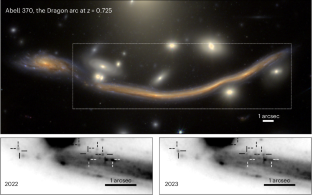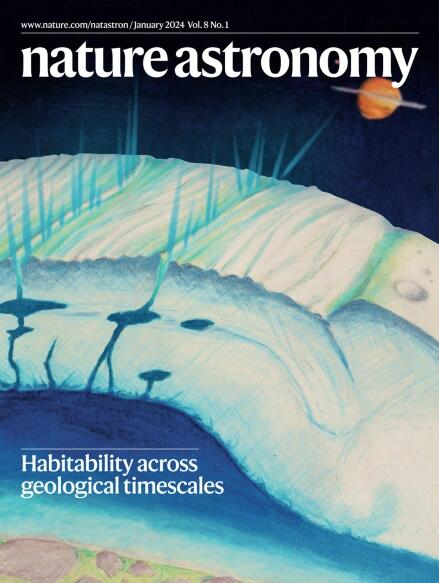Identification of more than 40 gravitationally magnified stars in a galaxy at redshift 0.725
IF 12.9
1区 物理与天体物理
Q1 ASTRONOMY & ASTROPHYSICS
引用次数: 0
Abstract
Strong gravitational magnification enables the detection of faint background sources and allows researchers to resolve their internal structures and even identify individual stars in distant galaxies. Highly magnified individual stars are useful in various applications, including studies of stellar populations in distant galaxies and constraining dark matter structures in the lensing plane. However, these applications have been hampered by the small number of individual stars observed, as typically one or a few stars are identified from each distant galaxy. Here, we report the discovery of more than 40 microlensed stars in a single galaxy behind Abell 370 at redshift of 0.725 (dubbed ‘the Dragon arc’) when the Universe was half of its current age, using James Webb Space Telescope observations with the time-domain technique. These events were found near the expected lensing critical curves, suggesting that these are magnified stars that appear as transients from intracluster stellar microlenses. Through multi-wavelength photometry, we constrained their stellar types and found that many of them are consistent with red giants or supergiants magnified by factors of hundreds. This finding reveals a high occurrence of microlensing events in the Dragon arc and demonstrates that time-domain observations by the James Webb Space Telescope could lead to the possibility of conducting statistical studies of high-redshift stars. Using JWST, more than 40 individual stars have been detected in a distant galaxy, dating back to when the Universe was only half of its current age. The stars appear to be red (super)giants that are magnified by factors of hundreds.


在红移0.725的星系中识别超过40颗引力放大的恒星
强大的引力放大率可以探测到微弱的背景源,并使研究人员能够解析它们的内部结构,甚至可以识别遥远星系中的单个恒星。高度放大的单个恒星在各种应用中都很有用,包括研究遥远星系的恒星群和透镜平面上的暗物质结构。然而,这些应用受到观测到的单个恒星数量较少的阻碍,因为通常从每个遥远的星系中识别出一颗或几颗恒星。在这里,我们报告了在Abell 370后面的一个星系中发现了40多颗微透镜恒星,红移为0.725(被称为“龙弧”),当时宇宙的年龄是目前年龄的一半,使用詹姆斯韦伯太空望远镜进行时域技术观测。这些事件是在预期的透镜临界曲线附近发现的,这表明这些被放大的恒星是星团内恒星微透镜的瞬态恒星。通过多波长测光,我们限制了它们的恒星类型,发现它们中的许多与放大数百倍的红巨星或超巨星一致。这一发现揭示了龙弧中微透镜事件的高发生率,并表明詹姆斯韦伯太空望远镜的时域观测可能导致对高红移恒星进行统计研究的可能性。
本文章由计算机程序翻译,如有差异,请以英文原文为准。
求助全文
约1分钟内获得全文
求助全文
来源期刊

Nature Astronomy
Physics and Astronomy-Astronomy and Astrophysics
CiteScore
19.50
自引率
2.80%
发文量
252
期刊介绍:
Nature Astronomy, the oldest science, has played a significant role in the history of Nature. Throughout the years, pioneering discoveries such as the first quasar, exoplanet, and understanding of spiral nebulae have been reported in the journal. With the introduction of Nature Astronomy, the field now receives expanded coverage, welcoming research in astronomy, astrophysics, and planetary science. The primary objective is to encourage closer collaboration among researchers in these related areas.
Similar to other journals under the Nature brand, Nature Astronomy boasts a devoted team of professional editors, ensuring fairness and rigorous peer-review processes. The journal maintains high standards in copy-editing and production, ensuring timely publication and editorial independence.
In addition to original research, Nature Astronomy publishes a wide range of content, including Comments, Reviews, News and Views, Features, and Correspondence. This diverse collection covers various disciplines within astronomy and includes contributions from a diverse range of voices.
 求助内容:
求助内容: 应助结果提醒方式:
应助结果提醒方式:


